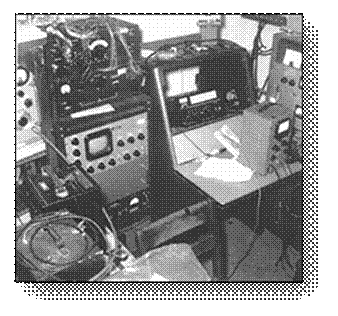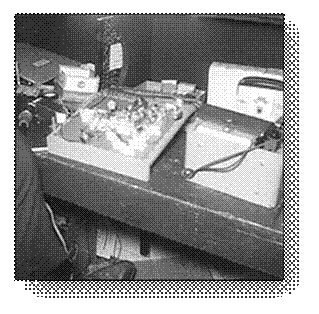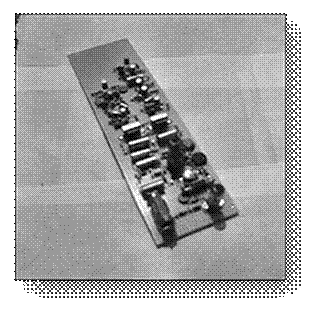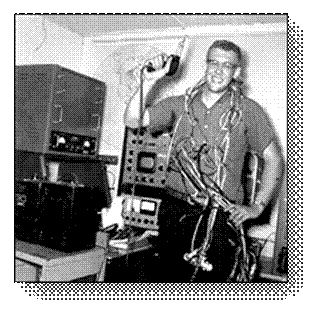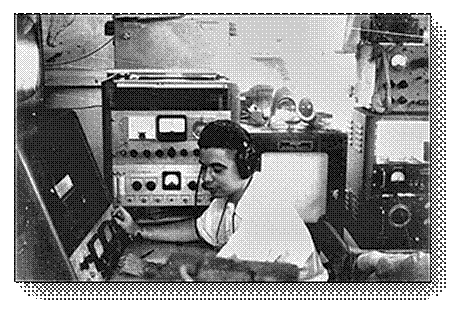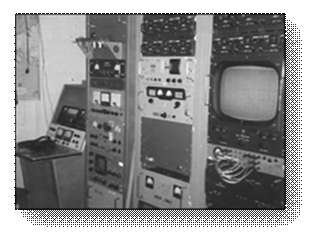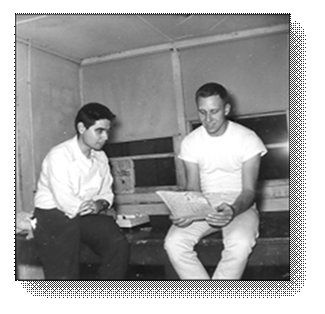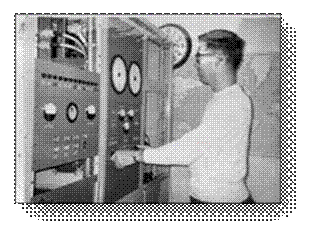|
What
can I say - where did this silly hat come from? The box to the left of my head is the
enclosure built by Norm for the original downconverter and power supply. |
University of Florida
Student Satellite Tracking Station
Recollections
by Dick Flagg
|
|
The
first formal organizational meeting for the tracking station took place in
Professor Latour's classroom at the exact time that President Kennedy was shot.
Our
Faculty Sponsor was Professor M. H. Latour. He worked at the Cape summers and taught
antennas (and many other courses) in the EE department at the University of
Florida in Gainesville. Professor Latour
was always very supportive of our efforts and often arranged for wonderful
pieces of relatively new surplus gear to come our way. Students included Norm Kevers, Max Robinson,
Bruce Blaze, Ralph Roth, Mario Guerrero, Alan Victor, Jim Bevel, Jerry, Dick
Flagg, and others. Norm, Max, and Dick
were the core group – with others joining in to help with various projects.
I
built a 137 MHz nuvistor downconverter while working as a summer student at
Patrick Air Force Base. This was built
with the help of some RCA techs working in a satellite tracking station atop
the Tech Lab. That was the summer I got
shark bitten on the foot. So here I was
at the end of the summer leaving the Tech Lab on crutches with my beautiful
downconverter in the bottom of my briefcase.
The guard at the door had the duty of checking the identity of everyone
coming in and also made sure that no one going out was taking anything with
them that wasn’t supposed to leave the building. The guard usually did a thorough job of
checking outgoing packages and briefcases but fortunately not that day – as I
handed him the briefcase to hold as I hobbled out thru the heavy front door.
We
mounted the downconverter and its power supply in a big steel box with blowers
and took that to the top of a 120 ft radar tower. This was a surplus
weather radar that was Professor Latour’s pride and joy. The 137 MHz antenna was a quarter wave stub
over a ground plane. There was an old Hallicrafters SX28 in the radar
console but it was pretty flaky so I used my NC125 receiver. Norm Kevers
scaled the radar tower and installed antennas and downconverter at the
top. Norm also built the power supply
and enclosure for the downconverter. As
I recall he got so interested in it that he skipped more than a few classes
that week.
|
VHF
(136 MHz) helix |
|
After
some time we moved to a one- story WW2 temporary dorm that had been converted
into office space. This building was located on what has become the
parking lot for the “Swamp” – the huge Gator football stadium. Our new site was several hundred yards from
the Radar tower and gave us lots more room. We put up several antennas on
the large flat roof - a 137 MHz helix, a 20 m dipole, and a crossed baseline
137 MHz interferometer using dipoles. The baseline was laid out very late
one night with a transit shooting Polaris. Campus police came and
questioned us as to what we were doing running around on the roof at 3 AM.
|
136
MHz dipole - part of the crossed baseline interferometer |
|
It
was here that we copied Morse
code and Russian voice from Vladimir Komarov on his Voskhod 1 flight in
October 1964. Earlier that day I had
heard HF signals from him in English sending greetings to the American
people. This was out at the radio
observatory at Biven’s Arm – a couple of miles from the UF campus. During the day we put up the 20 MHz dipole at
the tracking station on campus in preparation for an evening pass. Professor Latour came in and together we
operated the station. There was an old 8
channel Brush stripchart recorder which was set up to display signal
strength. Unfortunately the inking
system was partially clogged up and we were having a terrible time getting it
to write. This was where a piece of
aquarium tubing came to the rescue. So
there we are – Russian
voice booming over the loudspeaker with Professor Latour blowing
frantically thru the tube trying to keep the inking system pressurized long
enough to get a good strip chart recording.
We
won the engineering fair competition that year for the best student
project. I still remember Norm at the
blackboard explaining (in his best layman terms) the “out of roundness” of
elliptical orbits to a crowd of eager and clearly impressed onlookers.
Jerry
built up an SCR motor control for our steerable helix which was used for P-band
telemetry (215-260 MHz) (listen to Atlas FM/FM telemetry
and ATDA telemetry),
and Gemini voice on 296 MHz (listen to Gemini-9 here).
The downconverter was built in one night, right after final exams in June of
1965. We hoped to get it finished in
time for the next day’s launch of Gemini IV which would be highlighted by the
first American spacewalk by Ed White.
Unfortunately we never got it working till the next flight. It
turned out there was a shorted capacitor which we didn’t find till after the
flight was over. I kept adding turns to an inductor trying to get the
circuit to resonate but to no avail. Too
tired to understand the problem.
|
|
|
Mario with P-band
helix |
Dick adjusting
P-band preamps |
|
Tracking console -
Drake IIB receiver in center, HP608 on left |
Tense moments
during a Gemini flight. Dick and
Ralph. |
Max
Robinson built a phase lock loop tracking filter and detector driving an XY
plotter for measuring Doppler. Max had only 3% vision in one eye (and was
blind in the other). We tracked several boosters on P-band using this and could
even see staging on the Doppler plots. The PLL (called POLY) was built
along the lines of a unit built by the SOHIO tracking station and described in
QST. POLY also had a sweep feature which would scan over several tens of
kHz and then lock up when a signal appeared - good for short bursts of Doppler
shifted voice on Gemini.
|
|
|
Jerry
built a joystick controller for steering the helix which was on an old WW2
radar antenna mount. We wound the
steerable helix very late one night. We
dragged a torpedo shaped trash can out into the parking lot and I crouched
precariously on top of it as Norm ran around in an ever decreasing spiral
feeding out a spool of copper tubing which wound around the trash can. It is possible that beer was involved. Campus police came and questioned us as to
what we were doing running around the parking lot at 3 AM.
After
a year or so Professor Latour got a telemetry ground station for us surplus but
the freekin thing was at least 10 racks of demodulators and synchronizers and
we had quite a struggle to get any of it going.
Jim Bevel finally succeeded in demodulating a data tape which we found
in one of the drawers in the racks of telemetry equipment.
|
Give a kid some wire and a soldering gun and look
what you get. |
Then
a bit later he came up with the Telstar command antenna from the Cape – this
was a quad helix array on a big pedestal.
The mount went to Biven’s Arm (the radio astronomy observatory located a
couple of miles south of the UF campus).
Bruce Blaze and Alan Victor worked on getting it running – a huge
undertaking. That antenna mount was
fitted with P-band helixes and was used to track one of the Saturn
launches. Eventually the helices were
removed and a 30 ft dish was mounted on that pedestal just in time for Apollo
17. My one and only experience with heliarcing came when I built the
counterweight supports out of some very hefty aluminum channel. This antenna was used to track Apollo 17 at
the moon as well as to monitor Soviet Lunar missions. We used a tunnel diode low noise amplifier at
the feed for S-band. Tracking was
imprecise at first and often involved one team member standing behind the dish
waving their arms to indicate the direction to the moon. Sven Grahn
traveled from Sweden for the Apollo 17 launch and during his 3-week stay in
Gainesville we (and a gang from the physics and EE departments) erected the
dish and managed to copy voice signals from the crew in lunar orbit – “the
barber pole is gray.”
One
memorable event with the dish – I was out working in the control van alone –
doing some wiring on the azimuth control circuitry. Stupidly I got two wires reversed – hence
creating a positive feedback loop on the speed control. When I punched on the azimuth motor drive the
dish took off spinning and accelerated thru 90 degrees in just a few
seconds. Thank God I was looking out the
window at the time – and got it turned off before the dish spun off the
pedestal and into the lake.
The
antenna was also used for solar monitoring as part of the radio astronomy
program. Jeff Jeffries (a student helper
in the RA lab) equipped the control van with a high powered stereo. He would often bring young ladies out to
Biven’s Arm (to see the dish) and with floodlights on the dish he would slowly
elevate it to the sounds of the 1812 Overture.
Rumor has it that this ploy was hugely successful and Jeff would often
come into work in the morning with a large grin on his face.
There
was one final move of the satellite tracking station to Weil Hall – the main
engineering building on campus at the time.
Roof space was limited and we were all nearing graduation so the station
(and all those racks of the telemetry system) were abandoned in place in a top
floor room. The 30 ft dish and pedestal
were stolen from Biven’s Arm. Norm
joined the Air Force and later became a Captain for Delta Airlines. Max worked for a year or so in Physics and
Astronomy and then went to Western Kentucky to work in the EE department. I worked in Radio Astronomy for several years
– then went with Pan American World Airways as a telemetry engineer at Patrick
AFB. Norm, Max and Dick are all enjoying
our retirement years. Unfortunately time and circumstance have separated the
rest of us and I no longer know where they are.
I hope their memories of those years are as happy as mine are.
Thanks
to Max and Norm for their recollections, corrections to my faulty
recollections, and additional pictures.
Richard
Flagg
Honolulu
September
10, 2007
Additional pictures
|
Max at the
controls. Poly is in the top of the
half –rack behind Max. The infamous
Brush recorder in the center |
|
Yet another configuration - Nems Clarke TM receiver and spectrum
display in the center rack. Telemetry demodulation and display gear in the
right hand rack. |
|
Jerry in front of the Telstar antenna controller |
![]()







